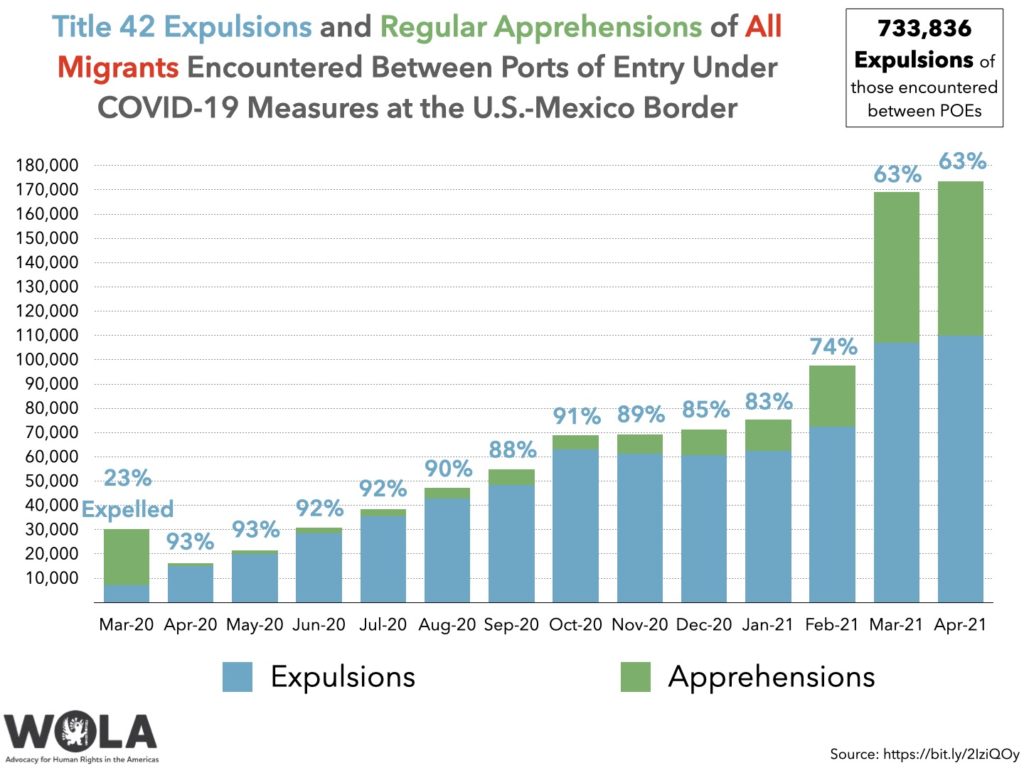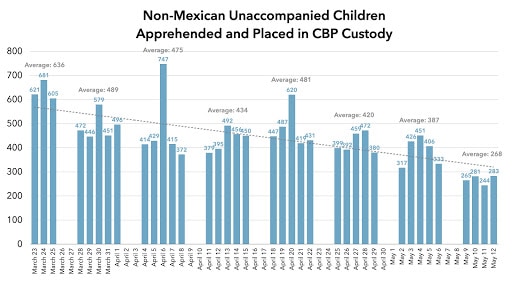With this series of weekly updates, WOLA seeks to cover the most important developments at the U.S.-Mexico border. See past weekly updates here.
Subscribe to the weekly border update
Support the Beyond the Wall campaign
Migration at the border flattened out in April
Despite spring normally being a time of greater migration, Border Patrol’s “encounters” with undocumented migrants crept up by only 2.5 percent from March to April. The surprisingly slow growth comes after encounters increased 30 percent in February and 73 percent in March.
With 173,460 migrants encountered, April 2021 was still Border Patrol’s heaviest month in 21 years (180,050 in April 2000). That number, though, counts “encounters” and not individual “people.” There is much double-counting: “CBP has reported that about 40 percent of the adults it arrests are ‘recidivists’ or repeat offenders,” according to the Washington Post.
That is a far higher recidivism rate than in recent years: it ranged from 7 to 16 percent between 2013 and 2019. Border Patrol first started reporting this rate in 2005, when it estimated 25 percent; the highest total before now was 29 percent recidivism in 2007.
Repeat crossings are more frequent now because of the pandemic border closure measure, known as “Title 42,” that the Trump administration put in place in March 2020 and the Biden administration has continued (public health experts have strongly criticized the “Title 42” measures as having no basis in protecting public health). In the name of preventing the spread of COVID-19, Border Patrol has been quickly expelling most migrants, usually with no opportunity to ask for asylum. This means most migrants from Mexico, El Salvador, Guatemala, and Honduras are expelled across the border into Mexico.
Border Patrol expelled 63 percent of migrants it encountered in April, the same proportion as March. In December 2020, the Trump administration’s last full month in office, expulsions stood at 85 percent.
Expulsion is a hardship for protection-seeking migrants, who normally seek to turn themselves in to CBP or Border Patrol. For migrants who wish to avoid being apprehended, though, expulsion has made the process easier: if they are caught, they get taken back across the border within hours, usually without even seeing the inside of a Border Patrol station, and in many cases try to cross again.
Single adult migrants are more likely than children or families to attempt to avoid apprehension, and thus to try crossing again after being expelled. Border Patrol’s encounters with single adults increased by 12 percent from March to April, to 108,301. Trying to avoid apprehension often means taking dangerous routes, such as through remote desert areas or by sea, and it appears that more migrants are dying on U.S. soil or in U.S. waters, the Wall Street Journal reported this week.
Encounters with unaccompanied children and members of family units, though, plummeted 10 percent—a result that almost nobody foresaw in March, when children and families increased by 102 percent and 177 percent, respectively.
Border Patrol encountered 48,226 family members, down 5,000 from March. The sharpest one-month decrease was in families from Guatemala (-29 percent) and Honduras (-22 percent), while families from “other countries”—neither Mexico nor Central America’s “Northern Triangle” region—jumped by 34 percent, to 14,448.

This appears to be an outcome of the Title 42 expulsions into Mexico. 48 percent of family members from El Salvador, Guatemala, and Honduras were expelled, similar to 47 percent in March (we reported a smaller percentage a month ago, but CBP radically revised its family expulsion data). With a roughly 50-50 chance of being expelled or being allowed to petition for asylum or protection inside the United States, Central American families face a confusing set of outcomes that smugglers are exploiting, reports Lomi Kriel at ProPublica / Texas Tribune. By contrast, Border Patrol expelled just 5 percent of family members from “other countries”—often places like Cuba or Venezuela where sending expulsion flights is not currently possible.
As noted in past updates, numbers of unaccompanied children continue to drop, even though the Biden administration is not expelling non-Mexican children who arrive. Border Patrol encountered an average of 268 non-Mexican children per day between May 9-12. This is a sharp drop from the 387 average of May 2-6, and the high 400s logged in late March and the first three weeks of April.
The agency encountered 2,268 Mexican children in April, almost identical to March (2,277). While almost none were expelled under Title 42, most were quickly repatriated back to Mexico, as was the norm before the pandemic, because the 2008 law requiring that unaccompanied children go into the asylum system only applies to kids from non-contiguous countries.

Only a daily average of 493 children were being processed in Border Patrol facilities during May 9-12, down from well over 5,000 in late March and early April. Nearly all were handed over to the Office of Refugee Resettlement’s (ORR) network of shelters within about 24 hours. The population of unaccompanied children in ORR shelters has also dropped to 20,397, the fewest since April 19 and down from an April 29 high of 22,557.
These shelters, which include convention centers, tent facilities, and a military base, face serious challenges of crowding, living conditions, and logistics, the New York Times reported, sharing an internal “senior leader brief” showing a thorough level of data collection. This week, the Dallas Morning News found that ORR had been keeping unaccompanied children for days at a time on buses parked outside a Dallas convention center that it is using as an emergency shelter. Politico reported that the White House has been leaning hard on Health and Human Services Secretary Xavier Becerra, whose department oversees ORR, to speed the pace at which the agency releases children to relatives or sponsors in the United States.
Late March predictions that ORR would need bed space for 34,000 or more children are now looking too pessimistic. With the drop in child and family migration has come a notable drop in press coverage of events at the border.
Family expulsions have generated a quiet crisis of family separation in Mexican border cities, as expelled parents, aware that unaccompanied children don’t get expelled, make the painful decision to send their children back into the United States alone. “Between January 20 and April 5, Border Patrol agents came across at least 2,121 unaccompanied migrant children who had been previously expelled,” CBS News reported. That is 24 family separations per day—one per hour.
Title 42 is easing, slightly
In April CBP expelled people 111,714 times under the Title 42 pandemic authority. On May 13 Department of Homeland Security (DHS) Secretary Alejandro Mayorkas told the Senate Homeland Security Committee that he did not have a timetable for lifting Title 42. Recent weeks, though, have seen some modest changes to the policy’s application to asylum seekers.
On May 12 CBS News got confirmation from CBP that the agency, citing “operational needs,” has stopped flying families from south Texas, where the bordering Mexican state of Tamaulipas has been limiting expulsions of families with small children, to other parts of the border where expulsions are easier. Since March 8, near-daily planeloads of people had been taking Central American families from McAllen, Texas to El Paso, Texas and San Diego, California. Witness at the Border, which monitors ICE flights, detected 60 of these “lateral” flights in April and 108 between March 8 and April 30, enough to expel about 10,000 people.
Once in El Paso and San Diego, DHS personnel were taking families to the borderline and leaving them in Mexico, often without telling them where they were or what was happening to them. Human Rights First discussed some of the families’ treatment at the hands of Border Patrol and other DHS personnel in a May 13 memo. U.S. media outlets have reported on tearful, disoriented families who had just been flown thousands of miles to be expelled.
The lateral expulsion flights have now stopped, although DHS is still busing some families from south Texas’s Rio Grande Valley region about four hours west to Laredo, in order to expel them into the organized crime-dominated border town of Nuevo Laredo. At a May 13 Senate Homeland Security Committee hearing, Sen. Josh Hawley (R-Missouri) accused DHS Secretary Mayorkas of canceling the expulsion flights in response to “left-wing groups.”
Another tiny erosion into Title 42 is a small but growing number of humanitarian exceptions for some of the most vulnerable expelled migrants who wish to seek asylum in the United States. “The latest plan is kicking off on a pilot basis,” a source told CNN, “adding that families will be put in immigration proceedings” in the United States. In recent weeks, about 35 vulnerable families a day have been exempted from expulsions, at the recommendation of the American Civil Liberties Union (ACLU), which is the plaintiff in a lawsuit against DHS seeking to overturn Title 42. It is not clear to what extent that number may expand. On May 13 the ACLU agreed to the latest in a series of delays to that lawsuit; the next deadline is May 25.
Border drug seizure data
Seven months into fiscal year 2021, CBP’s reporting on drugs detected at the U.S.-Mexico border points to big increases in fentanyl and cocaine seizures, a big drop in cannabis seizures, and little change in heroin and methamphetamine seizures. As in past years, nearly all drugs are seized by CBP agents at ports of entry, with the exception of marijuana:
- Fentanyl: 6,103 pounds seized October-April, 89 percent of it at ports of entry. If this pace is maintained through September, CBP will seize 10,462 pounds of fentanyl in FY 2021, a 130 percent increase over FY 2020.
- Cocaine: 17,407 pounds seized October-April, 86 percent of it at ports of entry. If this pace is maintained through September, CBP will seize 29,841 pounds of cocaine in FY 2021, a 57 percent increase over FY 2020.
- Heroin: 3,061 pounds seized October-April, 91 percent of it at ports of entry. If this pace is maintained through September, CBP will seize 5,247 pounds of heroin in FY 2021, a 2 percent increase over FY 2020.
- Methamphetamine: 99,681 pounds seized October-April, 93 percent of it at ports of entry. If this pace is maintained through September, CBP will seize 170,882 pounds of meth in FY 2021, almost identical to FY 2020.
- Marijuana: 162,073 pounds seized October-April, 39 percent of it at ports of entry. If this pace is maintained through September, CBP will seize 277,839 pounds of marijuana in FY 2021, a 45 percent decrease from FY 2020.
Links
- The Senate Homeland Security Committee held a March 13 hearing on the situation of unaccompanied minors, with DHS Secretary Mayorkas the lone witness. Committee Chairman Sen. Gary Peters (D-Michigan) noted the recent decline in arrivals of unaccompanied children and praised Border Patrol agents who were paying for toys out of their own pockets. Sen. Jacky Rosen (D-Nevada) voiced strong concerns about Title 42 expulsions, including the growing number of family separations discussed above.
- On the Republican side, Sen. Rob Portman (R-Ohio) lamented that, once in the United States, unaccompanied children are infrequently returned to their home countries, calling that an incentive for more children to come. Sens. Ron Johnson (R-Wisconsin), Mitt Romney (R-Utah), and Rick Scott (R-Florida) relied heavily on a prop: a chart of weekly apprehensions that appeared to show a sharp jump in migration after Joe Biden’s inauguration, but was simply wrong—based on a basic conflation of “apprehensions” and “encounters.” Sen. James Lankford (R-Oklahoma) said that overwhelmed Border Patrol agents had released 19,000 asylum-seeking family members into the United States without “notices to appear” in immigration court.
- Disgruntled with the Biden administration’s modest walk-back of the Trump administration’s hardline migration policies, some Border Patrol agents “are considering early retirement” or “are buying unofficial coins that say ‘U.S. Welcome Patrol,’” Reuters reports.
- A U.S. delegation led by National Security Council Western Hemisphere Director Juan González paid an in-person visit to Mexico on May 13. According to the Mexican Foreign Relations Secretariat’s release, topics covered included arms and narcotics trafficking, organized crime violence and financial flows, and “addiction as a public health problem.” The words “migration” or “border” do not appear.
- Reuters reports on how as many as 2,000 migrants, apparently misinformed about the Biden administration’s migration policies, have set up an encampment outside the busy El Chaparral pedestrian port of entry in Tijuana, across from San Ysidro, San Diego County, California. “The camp is growing increasingly dangerous, migrants and activists told Reuters, with unsanitary conditions, drug use, and gangs entering the area.”
- At Rest of World, Jeff Ernst reports on how migrant caravans—which haven’t successfully reached the United States since late 2018—are increasingly being organized by scammers trying to shake down desperate people over social media, especially in Honduras.
- El Paso Matters reports on the unique challenges faced by Indigenous migrants from Central America, many of whom speak little Spanish. “On a phone call with El Paso Matters, West Texas CBP spokesperson Landon Hutchens said that after hundreds of years since the Spanish colonization of the Americas, ‘you’d think (Indigenous immigrants) would have learned Spanish by now.’”
- A memo from Mijente and Just Futures Law warns of the civil liberties and migrant safety dangers of deploying surveillance and other technologies along the border—a measure that many border wall opponents in the Biden administration and Congress propose instead of a barrier. The memo lists some of the “Tech-Border-Industrial-Complex” corporations that would stand to gain from a big investment in drone and other surveillance technology.
- Tijuana municipal police found a cross-border “narco-tunnel” leading under the border wall into San Diego County’s Otay Mesa area. The tunnel began in a building located across the street from a Mexican National Guard barracks.
- USA Today published a long profile of Rep. Henry Cuéllar (D-Texas), whose district includes a large portion of the Texas border including Laredo. One of the most conservative Democrats in the House, Cuéllar has been a critic of the Biden administration.
- A Pew Research Center study of news coverage during the Biden administration’s first 60 days found that immigration was the subject of 11 percent of stories: 8 percent of stories in outlets with a “left-leaning audience,” and 20 percent of stories in outlets with a “right-leaning audience.”

 Adam Isacson
Adam Isacson